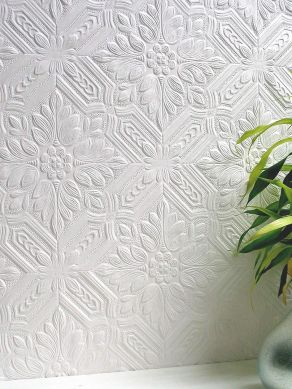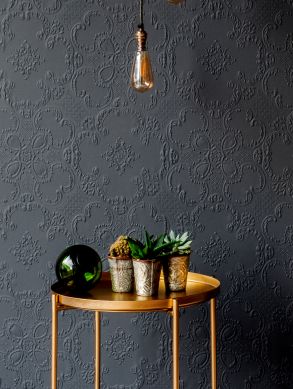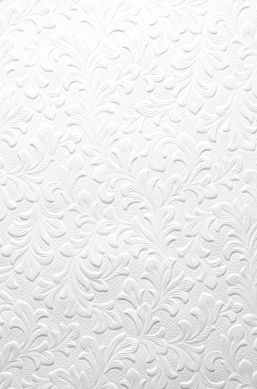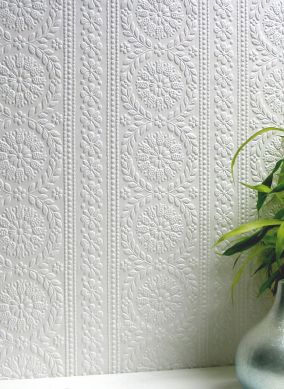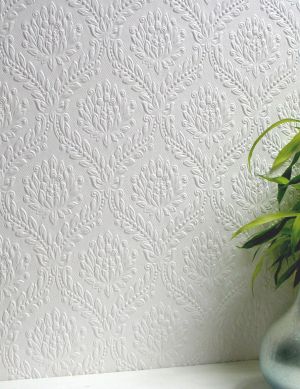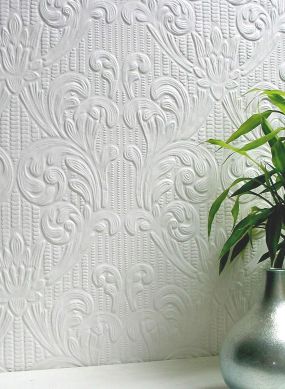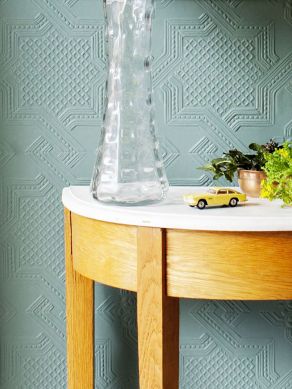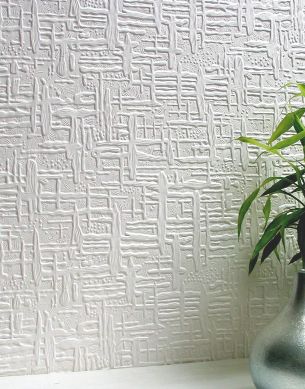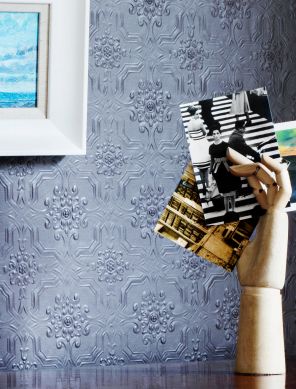Anaglypta Wallpaper
Anaglypta wallpaper: The Guide
Today, Anaglypta is globally considered synonymous with textured embossed wallpapers that can be painted over. The unique patterns are mostly based on original designs from the Victorian era, when these wallpapers were first created. These relief-like models with fantastic three-dimensional textures offer another advantage: They can be painted over in any colour - and not just once! Anaglypta wallpaper is suitable for every style and can be found in public buildings, historic villas and Art Deco flats around the globe.
Table of Contents
- What does Anaglypta mean?
- How was the Anaglypta wallpaper brand created?
- What is the difference between Anaglypta and Lincrusta?
- What is the special feature of Supaglypta?
- Which rooms is Anaglypta wallpaper suitable for?
- How can Anaglypta wallpapers be painted over?
- Why are Anaglypta wallpapers also a highlight for the ceiling?
What does Anaglypta mean?
The word is of Greek origin. In the wallpaper world, Anaglypta is synonymous with textured, embossed and paintable wallpapers from the traditional British wallpaper brand of the same name.
Greek origin
Translated from the Greek, "anaglypta" means "raised cameo", i.e. the raised relief on a decorative gemstone. And the special embossing structures of these high-quality relief models made of paper, produced by British wallpaper manufacturer Anaglypta, are an obvious reference to this.
Synonymous with paintable wallpaper
Thanks to the British wallpaper label of the same name, Anaglypta has become an international term for paintable wallpapers that are characterised by embossed and structured pattern surfaces. They are made from wood pulp and the embossed patterns form fantastic, three-dimensional textures. These versatile wallpapers can be painted over in any colour.
Traditional British wallpaper brand
Anaglypta is a classic and extremely well-known wallpaper brand. The history of this traditional company goes back to the 19th century. The founder and developer of this extraordinary wallpaper brand made of sustainable paper was Thomas Palmer. In the context of the restoration of many historic buildings in recent decades, the brand enjoyed a second era of popularity.
How was the Anaglypta wallpaper brand created?
In the Victorian era, the art of stuccowork flourished and a fabulous variety of plaster reliefs adorned houses inside and out. As a result, Thomas Palmer developed the first embossed wallpaper to imitate plaster reliefs.
Victorian stuccoworkers' art in the 19th century
During her reign from 1837 to 1901, Queen Victoria (1819-1901) shaped the Victorian era and the resulting style in terms of fashion, architecture & interior design. One of the main characteristics of this era is the craftsmanship of the stuccoworkers, which was in great demand at the time. Almost every grand house was decorated inside and out with unique plaster reliefs.
Development of embossed wallpaper to imitate plaster reliefs
The multi-dimensional beauty of plaster reliefs combined with contemporary patterns aroused the creative interest of Thomas Palmer. He wanted to imitate the plaster reliefs on wallpaper in order to make them accessible to the masses. In 1887, he developed a process to produce an embossed paper with relief structures. Production started at Storeys Mill, Lancaster.
Rapid rise to wallpaper manufacturer
In 1887, the Manchester Exhibition took place on the occasion of Queen Victoria's Golden Jubilee and gave Palmer the opportunity to present his innovative wallpaper creation. Demand increased immensely and the pattern designs were continuously adapted to the changing styles of the times. By 1894, the company had 100 employees and was relocated to Potters Mill, Darwen.
Traditional production and pattern designs
Anaglypta wallpaper is white, which gives it an elegant touch thanks to the relief-like structures (mostly original designs from the 19th century). It is explicitly intended to be painted over. Today, as in the past, the wallpapers are produced on traditional paper and paste substrates. The embossing process is done on heavy presses by Crown Berger Co. in Darwen, Lancashire, the centre of the British wall décor industry.
What is the difference between Anaglypta and Lincrusta?
"Lincrusta" is a very hard-wearing wall covering similar to linoleum. As this material has some disadvantages, Lincrusta manager Thomas Palmer created an alternative made of paper - Anaglypta - which can compensate for the disadvantages and even offers some additional advantages.
Lincrusta - a linoleum-like, highly durable wall covering
The name Lincrusta for wall coverings and wallpapers is a combination of the Latin words linum = linen and crusta = hard shell. This is a material similar to linoleum which is primarily used for the production of wall décor. This stable, pressure- and impact-resistant wall covering with stucco-like reliefs was introduced to the market in 1877.
Composition of Lincrusta wall covering
Lincrusta is composed of a carrier material and the Lincrusta pulp, a kind of jellied paste made of linseed oil and wood flour. Lincrusta is like a thin version of embossed linoleum, but heavier and more durable than Anaglypta. Frederick Walton invented the first washable wall covering in 1877, and the brand name Lincrusta is protected.
Disadvantage of Lincrusta causes Palmer to develop a new plan
Despite its advantages, Lincrusta has one major disadvantage: the stiffness of the material. Thomas Palmer, then Lincrusta's London manager, created Anaglypta as a lightweight and flexible alternative made of cellulose and cotton. He faced the difficult challenge of embossing the paper pulp before it had reached the stage of finished paper.
Advantages of Anaglypta
Unlike Lincrusta, Anaglypta is embossed from the back, creating hollow areas. This wallpaper is significantly lighter and easier to work with. In addition, it can be painted over and provides a fantastic feel that invites you to touch it. Furthermore, the core idea of developing a product that is honest, interesting, and attractive has stood the test of time to this day.
What is the special feature of Supaglypta?
Supaglypta is a material variant of Anaglypta and is considered one of the most robust wallpapers in the world. In addition to authentic vintage chic, it offers legendary durability and longevity.
Supaglypta as a material variant
As a particularly strong material type, Supaglypta is one of the most robust wallpapers in the world (available in our Shop). A layer reinforced with a textile compound is combined with a layer of high-quality paper. The deeply structured, embossed wallpaper has an extremely hard-wearing surface and is predestined for use in heavily frequented rooms and areas.
Authentic vintage chic and legendary durability in one
Thomas J. Palmer developed his unique Anaglypta and Supaglypta processes more than 125 years ago. The aim of developing Supaglypta was to create a tough, long-lasting wallpaper that would stay true to life while being easy to maintain. Most of the sophisticated pattern designs exude true vintage chic and date back to the brand's beginnings.
Which rooms is Anaglypta wallpaper suitable for?
These exquisite wallpaper models can be admired in public buildings, historic mansions or luxury flats all over the globe. Anaglypta provides a plethora of individual colour design options, offers hard-wearing wall coverings, conceals defects and guarantees legendary durability.
Worldwide presence in historic mansions, apartments and public buildings
Whether in restaurants, theatres, or cinemas: Anaglypta wallpapers can be found all over the world in public spaces of all kinds. They also adorn the walls of typical Victorian mansions and Modernist-style townhouses as well as Art Deco flats around the globe. In addition, these paintable relief wallpapers are in high demand in contemporary hotels and department stores.
Suitable for all interior design styles
Designs by Anaglypta cater to every type of style, from traditional to eclectic. They spread class, sophistication and vintage charm in any home. The original graphic and ornamental designs from the 19th century have lost none of their charm and are as popular as ever. A fine selection of Heritage and Contemporary designs tells the company's story in exemplary fashion.
Individual colour design by painting over
Anaglypta wallpapers are designed to be painted over in any chosen colour. The raised pattern contours can also be treated with paint which produces a special effect if a suitable colour tone is chosen for this purpose. With embossed wallpapers, individual colour choices, e.g. a modern or traditional finish,are the name of the game.
Hard-wearing wall covering for base, hallway, staircase and ceiling
Anaglypta is a robust wall covering that, in the 1970s, enjoyed a huge revival with the first wave of renovations in San Francisco's Victorian neighbourhoods. This hard-wearing relief wallpaper is particularly suitable for hallways, stairways and ceilings and can be painted over several times. It is popular for wallpapering the area below a dado rail on the wall.
Conceals defects and proves legendary durability
Anaglypta and especially Supaglypta wallpapers are particularly good at concealing defects such as cracks in plaster walls and ceilings thanks to their "hollow" back and reinforced carrier materials. Their legendary durability and lifespan are unbeatable, with the added bonus that they can be painted over several times.
How can Anaglypta wallpapers be painted over?
Anaglypta wallpapers require suitable paints and the use of a primer is recommended. The colour choice should be based on the use or purpose of the room.
Suitable wall paints
Latex paint is the first choice. Professionals prefer high-gloss paint for ceilings to emphasise the pattern design. After wallpapering, a drying period of at least 48 hours should be observed as the paste must be completely dry before painting. If and when the previous colour scheme is no longer to your liking, the wallpaper can simply be repainted.
Colour choice according to room use and purpose
The manufacturer recommends different colour schemes depending on the purpose of the room. A coat of white paint provides a clean, crisp finish that looks good in any room. Neutral and light colours capture the mood, adding elegance and sophistication to kitchens and hallways. Strong colours, used sparingly, create dramatic effects; they are also suitable for feature walls in small spaces.
Using primer
After painting textured paper, white spots can often appear. Due to the embossed patterns, Anaglypta wallpapers are very porous which is why they absorb more paint. A lightly tinted primer should therefore be applied before painting. It closes the pores and the need for multiple paint applications can be avoided.
Step-by-step guide
- Thoroughly vacuum the wallpaper to remove dust.
- Fix loose seams and corners with dispersion adhesive.
- Apply primer evenly to the entire wallpaper surface by brushing, rolling or spraying.
- After drying, carefully inspect the wall and touch up areas that haven't been completely covered with paint.
- Allow wallpaper to dry thoroughly, at least for 12 hours.
- Paint, roll or spray the entire surface with the chosen base colour.
- Allow the base colour to dry, again for at least 12 hours.
- Using a sponge or a small brush, the raised pattern can now be carefully painted over with gloss paint.
- Allow the paint to dry thoroughly.
Tips for optimum painting results
- Please note: When painting Anaglypta wallpaper, avoid pressing on the paint roller or brush too hard as this will flatten the raised areas of the paper. Paint sprayers prevent this unintended effect.
- The layer of paint should not penetrate or soak the paper, as this weakens the adhesive bond to the wall.
- The application of paint (i.e. the liquid) can cause the wallpaper to expand. To achieve perfect results, the adhesive bond should always be fully dried and hardened before painting so that the surface cannot expand. If the adhesive strength is insufficient, the seams can open up, which is why they should be checked after drying and touched up if necessary.
Why are Anaglypta wallpapers also a highlight for the ceiling?
Anaglypta wallpapers are the perfect way to create a fresh, eye-catching ceiling. This designer wallpaper can even imitate a historical ceiling design. After wallpapering, it can be left white or painted in any colour.
Fresh, eye-catching ceilings in no time at all
An unsightly ceiling is quickly and easily transformed into an attractive eye-catcher with embossed pattern wallpapers by Anaglypta. The ceiling can be redesigned or quickly renovated by repainting at any time.
Imitation of historical ceiling design
The opulent pattern designs imitate the look of the pressed tin ceilings in historical architecture, giving the room a refined character. Metallic paints can be used to give the surface a look reminiscent of tin, copper or other aged materials.
Wallpapering and painting the ceiling
To wallpaper the ceiling, it is best to have assistance. After putting the Anaglypta wallpaper up, it can either be left in its original white colour, be whitewashed once for extra freshness, or be painted in a colour of your choice.


